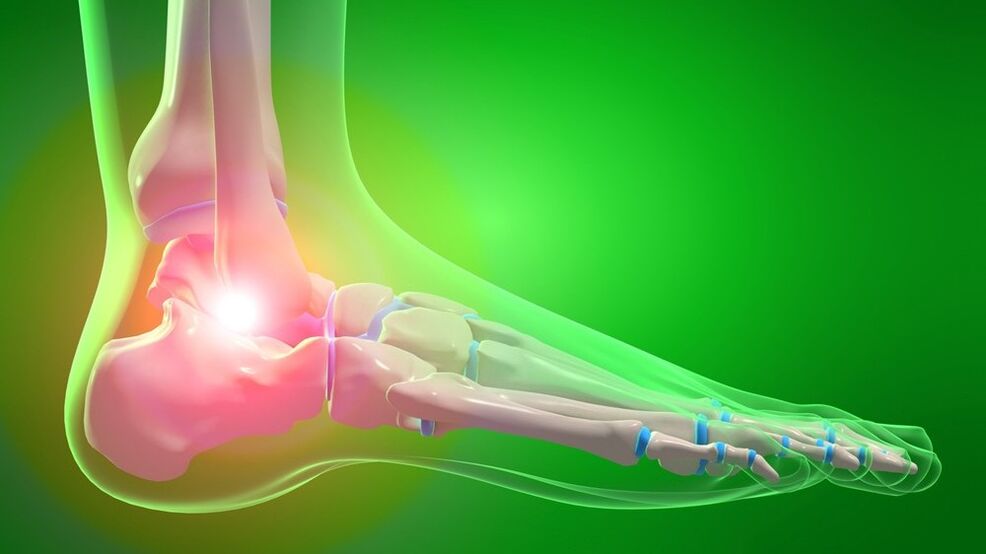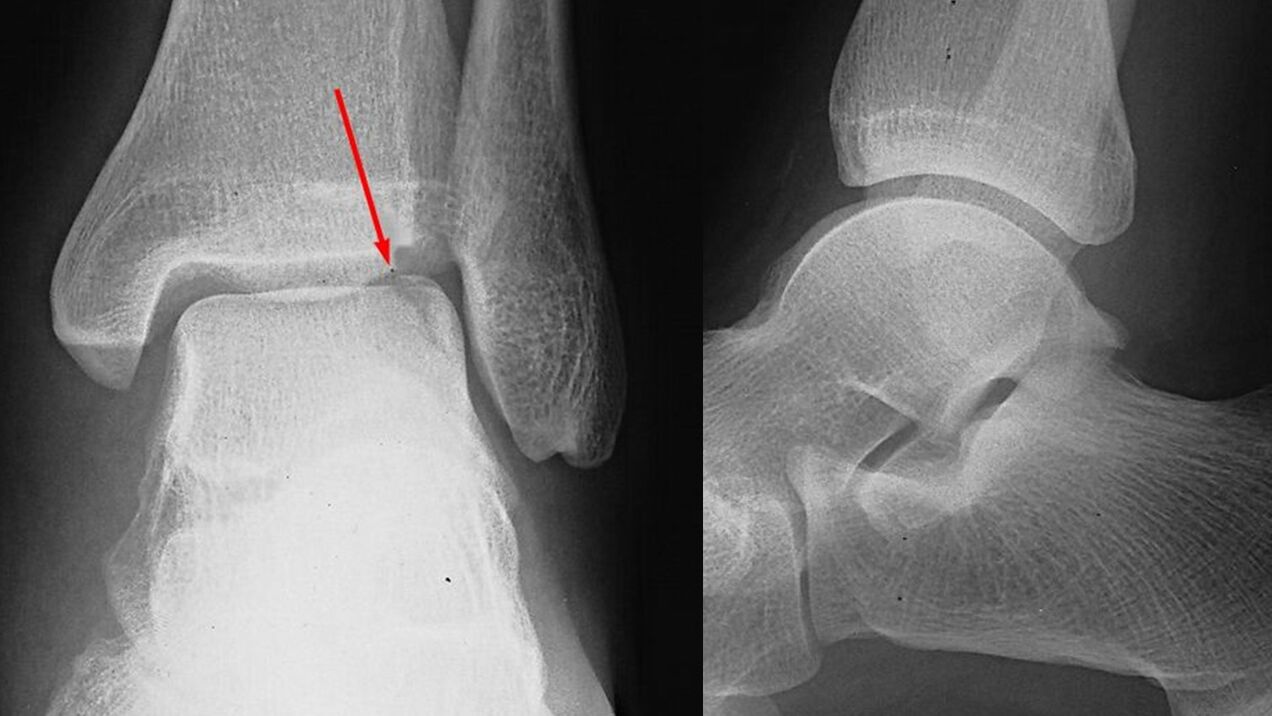Osteoarthritis of the ankle joint is a chronic disease that affects the articular cartilage, and then other joint structures (capsule, synovium, bones, ligaments). It has a degenerative-dystrophic character. It is manifested by pain and limitation of movement, followed by progressive impairment of support and walking functions. The diagnosis is made on the basis of symptoms, examination and radiography. Treatment is usually conservative, using anti-inflammatory drugs, chondroprotectors and glucocorticoids, and prescribing exercise therapy and physical therapy. In severe cases, sanitary arthroscopy, arthrodesis or endoprosthetics are performed.

General information
Osteoarthritis of the ankle joint is a disease in which joint cartilage and surrounding tissues are gradually destroyed. The disease is based on degenerative-dystrophic processes, and inflammation in the joint is secondary. Arthrosis has a chronic undulating course with alternating remissions and exacerbations, and gradually progresses. Women and men suffer equally often. The probability of development increases sharply with age. At the same time, experts note that the disease is "getting younger" - every third case of ankle arthrosis is currently detected in people younger than 45 years old.
Causes
Primary arthrosis occurs without any apparent reason. Secondary damage to the ankle joint occurs under the influence of some unfavorable factors. In both cases, the basis is a violation of metabolic processes in cartilage tissue. The main causes and predisposing factors for secondary arthrosis of the ankle joint are:
- major intra- and peri-articular injuries (fractures of the talus, fractures of the ankle joint, tears and ruptures of ligaments);
- ankle surgery;
- excessive load: too intense sports, long walking or constant standing due to working conditions;
- wearing shoes with heels, overweight, constant microtraumas;
- diseases and conditions associated with metabolic disorders (diabetes mellitus, gout, pseudogout, estrogen deficiency in postmenopause);
- rheumatic diseases (SLE, rheumatoid arthritis);
- osteochondrosis of the lumbar spine, intervertebral hernia and other conditions that are accompanied by pinching of nerves and disruption of the muscular system of the feet and legs.
Less often, the cause of arthrosis is non-specific purulent arthritis, arthritis caused by specific infections (tuberculosis, syphilis) and congenital developmental anomalies. Unfavorable environmental conditions and hereditary predisposition play a certain role in the development of arthrosis.
Pathogenesis
Normally, articular surfaces are smooth, elastic, slide smoothly relative to each other during movement and provide effective shock absorption under load. As a result of mechanical damage (trauma) or metabolic disorders, cartilage loses its smoothness, becomes rough and inelastic. Cartilage "rubs" during movement and injures each other, which leads to worsening of pathological changes.
Due to insufficient cushioning, the excess load is transferred to the basic bone structure, and degenerative-dystrophic disorders develop in it: the bone is deformed and grows along the edges of the joint area. Due to secondary trauma and disruption of the normal biomechanics of the joint, not only the cartilage and bone, but also the surrounding tissues suffer.
The joint capsule and synovial membrane thicken, and foci of fibrous degeneration form in the ligaments and periarticular muscles. The joint's ability to participate in movements and withstand loads decreases. Instability appears and pain progresses. In severe cases, joint surfaces are destroyed, the supporting function of the limb is weakened, and movements become impossible.
Symptoms
Initially, after a significant load, rapid fatigue and slight pain in the ankle joint are detected. After that, the pain syndrome becomes more and more intense, its nature and time of onset change. Recognizable characteristics of pain in arthrosis are:
- Initial pain. They appear after a state of rest and then gradually disappear with movement.
- Load dependence. There is increased pain during exercise (standing, walking) and rapid joint fatigue.
- Night pain. They usually appear in the morning.
The condition changes in waves, during exacerbations the symptoms are more pronounced, in the phase of remission they first disappear and then become less intense. There is a gradual progression of symptoms over several years or decades. Along with pain, the following manifestations are also determined:
- A creaking, screeching or clicking sound may occur when moving.
- During an exacerbation, the periarticular area sometimes swells and reddens.
- Due to the instability of the joint, the patient often twists the leg, which causes sprains and tearing of ligaments.
- Stiffness and limited movement are noted.
Complications
During an exacerbation, reactive synovitis may occur, accompanied by fluid accumulation in the joint. In the later stages, pronounced deformation is revealed. Movements are severely restricted and contractures develop. Support becomes difficult; when moving, patients are forced to use crutches or a cane. There is a reduction or loss of working ability.
Diagnostics
The diagnosis of arthrosis of the ankle joint is made by an orthopedic doctor based on a survey, external examination data and the results of additional studies. When examined in the initial stages, there may be no changes, but later deformities, limitation of movement and pain on palpation are revealed. Leading importance is given to visualization techniques:
- X-ray of the ankle joint. It has a decisive role in diagnosing and determining the degree of arthrosis. Pathology is indicated by the narrowing of the joint space, the proliferation of the edges of the joint surfaces (osteophytes). In the later stage, cystic formations and osteosclerosis of the subchondral (located under the cartilage) zone of the bone are revealed.
- Tomographic studies. Use when indicated. In severe cases, for a more accurate assessment of the state of the bone structures, the patient is additionally sent for computerized tomography, and for examination of soft tissues - for MR of the ankle joint.
Laboratory tests were unchanged. If necessary, in order to determine the cause of arthrosis and differential diagnosis with other diseases, consultations of related specialists are prescribed: neurologist, rheumatologist, endocrinologist.

Treatment of arthrosis of the ankle joint
Treatment of pathology is long-term and complex. Patients are usually seen by an orthopedic surgeon on an outpatient basis. In the period of exacerbation, hospitalization in the department of traumatology and orthopedics is possible. The most important role in slowing down the progression of arthrosis is played by lifestyle and proper physical activity, so the patient is given recommendations for losing weight and optimizing the load on the leg.
Drug therapy
It is selected individually, taking into account the stage of arthrosis, severity of symptoms and accompanying diseases. Includes general and local agents. The following groups of drugs are used:
- General NSAIDs. Tablet forms are commonly used. Medicines have a negative effect on the stomach lining, so "gentle" medicines are preferable for gastrointestinal diseases.
- Topical NSAIDs. It is recommended both in the period of exacerbation and in the phase of remission. It can be prescribed as an alternative if side effects occur from the tablet form. Available in ointment and gel form.
- Chondroprotectors. Substances that help normalize metabolic processes in cartilage tissue. They are used in the form of creams, gels and preparations for intra-articular application. Use medications containing glucosamine and collagen hydrolyzate.
- Hormonal agents. In cases of severe pain that cannot be alleviated with medication, intra-articular corticosteroids are applied a maximum of 4 times a year.
- Metabolic stimulants. To improve local blood circulation and activate tissue metabolism, nicotinic acid is prescribed.
Physiotherapy treatment
The patient is prescribed a complex of physical therapy, developed taking into account the manifestations and stage of the disease. The patient is referred to physiotherapy. In the treatment of arthrosis, massage and UHF are used. In addition, in the treatment of pathology they use:
- laser therapy;
- thermal procedures;
- medical electrophoresis and ultraphonophoresis.
Operation
Indicated in the later stages of the disease when conservative therapy is ineffective, pronounced pain syndrome, worsening of the patients' quality of life or limited work ability. Operations are performed in a hospital environment, they are open and minimally invasive:
- Arthroscopic interventions. If significant cartilage destruction occurs, arthroscopic chondroplasty is performed. Sanitary arthroscopy (removal of formations that interfere with movement) is usually performed for severe pain in stage 2 arthrosis. The effect lasts for several years.
- Ankle arthrodesis. It is performed in the case of significant destruction of the joint surfaces, includes removal of the joint and "fusion" of the bones of the foot and lower leg. It allows restoration of the supporting function of the limb in case of loss of joint mobility.
- Endoprosthetics of the ankle joint. It is performed in advanced arthrosis. It involves removing the destroyed articular surfaces of the bones and replacing them with plastic, ceramic or metal prostheses. Movements are completely restored, the service life of the prosthesis is 20-25 years.
Forecast
Changes in the joint are irreversible, but the slow progression of arthrosis, timely initiation of treatment and compliance with the recommendations of an orthopedic traumatologist in most cases allow the preservation of working capacity and a high quality of life decades after the onset. first symptoms. With the rapid increase in pathological changes, endoprosthetics makes it possible to avoid disability.
Prevention
Preventive measures include reducing the degree of injury, especially in winter, in periods of frost. If you are overweight, you should take measures to reduce your body weight to reduce the stress on the joint. A regime of moderate physical activity should be maintained, overloads and microtraumas should be avoided, and diseases that can cause the development of arthrosis of the ankle joint should be treated in a timely manner.



































